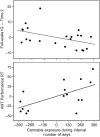Adverse Effects of Cannabis on Adolescent Brain Development: A Longitudinal Study
- PMID: 26912785
- PMCID: PMC5963818
- DOI: 10.1093/cercor/bhw015
Adverse Effects of Cannabis on Adolescent Brain Development: A Longitudinal Study
Abstract
Cannabis is widely perceived as a safe recreational drug and its use is increasing in youth. It is important to understand the implications of cannabis use during childhood and adolescence on brain development. This is the first longitudinal study that compared resting functional connectivity of frontally mediated networks between 43 healthy controls (HCs; 20 females; age M = 16.5 ± 2.7) and 22 treatment-seeking adolescents with cannabis use disorder (CUD; 8 females; age M = 17.6 ± 2.4). Increases in resting functional connectivity between caudal anterior cingulate cortex (ACC) and superior frontal gyrus across time were found in HC, but not in CUD. CUD showed a decrease in functional connectivity between caudal ACC and dorsolateral and orbitofrontal cortices across time. Lower functional connectivity between caudal ACC cortex and orbitofrontal cortex at baseline predicted higher amounts of cannabis use during the following 18 months. Finally, high amounts of cannabis use during the 18-month interval predicted lower intelligence quotient and slower cognitive function measured at follow-up. These data provide compelling longitudinal evidence suggesting that repeated exposure to cannabis during adolescence may have detrimental effects on brain resting functional connectivity, intelligence, and cognitive function.
Keywords: cannabis; cognition; development; functional connectivity; longitudinal.
© The Author 2016. Published by Oxford University Press. All rights reserved. For Permissions, please e-mail: journals.permissions@oup.com.
Figures





Similar articles
-
Cannabis and cocaine decrease cognitive impulse control and functional corticostriatal connectivity in drug users with low activity DBH genotypes.Brain Imaging Behav. 2016 Dec;10(4):1254-1263. doi: 10.1007/s11682-015-9488-z. Brain Imaging Behav. 2016. PMID: 26667034 Free PMC article. Clinical Trial.
-
Understanding marijuana's effects on functional connectivity of the default mode network in patients with schizophrenia and co-occurring cannabis use disorder: A pilot investigation.Schizophr Res. 2018 Apr;194:70-77. doi: 10.1016/j.schres.2017.07.029. Epub 2017 Aug 18. Schizophr Res. 2018. PMID: 28823723 Free PMC article.
-
Impaired functional connectivity of brain reward circuitry in patients with schizophrenia and cannabis use disorder: Effects of cannabis and THC.Schizophr Res. 2014 Sep;158(1-3):176-82. doi: 10.1016/j.schres.2014.04.033. Epub 2014 Jul 16. Schizophr Res. 2014. PMID: 25037524 Free PMC article.
-
Regular cannabis use is associated with altered activation of central executive and default mode networks even after prolonged abstinence in adolescent users: Results from a complementary meta-analysis.Neurosci Biobehav Rev. 2019 Jan;96:45-55. doi: 10.1016/j.neubiorev.2018.10.026. Epub 2018 Nov 3. Neurosci Biobehav Rev. 2019. PMID: 30395923 Free PMC article.
-
Cannabis and the developing brain: What does the evidence say?Birth Defects Res. 2019 Oct 15;111(17):1302-1307. doi: 10.1002/bdr2.1572. Epub 2019 Aug 5. Birth Defects Res. 2019. PMID: 31385460 Free PMC article. Review.
Cited by
-
Which came first: Cannabis use or deficits in impulse control?Prog Neuropsychopharmacol Biol Psychiatry. 2021 Mar 2;106:110066. doi: 10.1016/j.pnpbp.2020.110066. Epub 2020 Aug 11. Prog Neuropsychopharmacol Biol Psychiatry. 2021. PMID: 32795592 Free PMC article. Review.
-
Medical Cannabis in Pediatric Oncology: Friend or Foe?Pharmaceuticals (Basel). 2022 Mar 16;15(3):359. doi: 10.3390/ph15030359. Pharmaceuticals (Basel). 2022. PMID: 35337156 Free PMC article. Review.
-
The long-term cognitive consequences of adolescent exposure to recreational drugs of abuse.Learn Mem. 2018 Aug 16;25(9):481-491. doi: 10.1101/lm.046672.117. Print 2018 Sep. Learn Mem. 2018. PMID: 30115770 Free PMC article. Review.
-
Marijuana use among adolescent multiple tobacco product users and unique risks of dual tobacco and marijuana use.Drug Alcohol Depend. 2018 Aug 1;189:80-89. doi: 10.1016/j.drugalcdep.2018.04.031. Epub 2018 May 31. Drug Alcohol Depend. 2018. PMID: 29890454 Free PMC article.
-
Altered cerebellar-cortical resting-state functional connectivity in cannabis users.J Psychopharmacol. 2021 Jul;35(7):823-832. doi: 10.1177/02698811211019291. Epub 2021 May 25. J Psychopharmacol. 2021. PMID: 34034553 Free PMC article.
References
-
- Biswal B, Yetkin FZ, Haughton VM, Hyde JS. 1995. Functional connectivity in the motor cortex of resting human brain using echo-planar MRI. Magn Reson Med. 34:537–541. - PubMed
-
- Bolla KI, Brown K, Eldreth D, Tate K, Cadet JL. 2002. Dose-related neurocognitive effects of marijuana use. Neurology. 59:1337–1343. - PubMed
Publication types
MeSH terms
Grants and funding
LinkOut - more resources
Full Text Sources
Other Literature Sources

